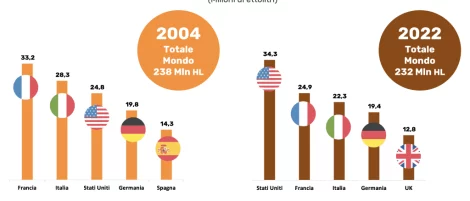Shift in demand and production from red wines to whites; the United States emerges as the leading consumer market; Italian wine exports nearly tripled, driven by sparkling wines. These are the main changes in the global wine landscape over the past 20 years, as recorded by the Wine Monitor Observatory. The study was presented in Rome at the new headquarters of the Foreign Press (Palazzo Grazioli) to kick off the year of celebrations for the 20th anniversary of the Grandi Marchi Institute, the group that brings together 18 of the main Italian wine brands.
The U.S. Overtake
First and foremost, in this timeframe, there has been a shift in consumer countries. If in 2004 France led the pack (33.2 million hectoliters consumed), with Italy in second place (28.3 million), followed by the United States (24.8 million), today the latter has secured the podium, reaching 34.3 million hectoliters consumed. Consequently, they have also become the leading country for imports, doubling the values (from 2.7 billion euros to 6.2) and surpassing the United Kingdom (now at 4.6 billion). In the ranking of exporters, France (now valued at almost 12 billion euros) and Italy (7.7 billion) continue to hold their positions, while Australia (third place in 2004) has been overtaken by Spain and Chile. "But the reason lies in the interruption of trade relations with China - explains Observatory Manager Denis Pantini - which has lowered values over the past two years." The recently announced peace between Beijing and Melbourne could change the scenario again.

Production and Consumption Towards White Wines
Meanwhile, in Italy (but this also applies to the rest of the world), production has decidedly changed in terms of type and color. If in 2004 reds represented over half of the production (out of 53.1 million hectoliters total in 2004, reds accounted for 28.7 million hectoliters vs. whites at 24.4 million hectoliters), today that ratio appears reversed: out of a production of 38.3 million hectoliters, reds register just 14.5 million and whites 23.7 million. But production is only a reflection of the change in consumption, which sees still white wines at the top (40% of the shares), followed by still reds (38%), sparkling wines booming (14%), and rosés (8%). "And it's precisely sparkling wines that have driven Italian exports in these 20 years, along with the repositioning of still wines at appellation prices," concludes Pantini.
A Documentary Film for the 20 Years of Grandi Marchi
"At the beginning of the 2000s, in a scenario where few would have bet on a group format composed of actors used to being protagonists individually, the Grandi Marchi Institute immediately took the right path," says President Piero Mastroberardino. "Today, the crisis doesn't scare us because we've already overcome quite a few crises and changes." Meanwhile, to celebrate the 20th anniversary of Grandi Marchi, a packed program of events and initiatives is announced. Firstly, the new venue, which, with the payoff "wine family heritage," emphasizes the family component of the group. Then the launch of a documentary film that tells the story of the 18 Grandi Marchi families, not forgetting the new generations who, in Mastroberardino's words, "represent a different perspective on wine": about ten young people ready to make their mark with a new approach and GenZ-proof language. The documentary will be screened in September and then made available on major platforms. Finally, on June 18, Igm will be the protagonist of a major charity event at Hangar Bicocca (Milan) in collaboration with Progetto Itaca, which deals with supporting and rehabilitating people with mental health disorders.


 US tariffs: here are the Italian wines most at risk, from Pinot Grigio to Chianti Classico
US tariffs: here are the Italian wines most at risk, from Pinot Grigio to Chianti Classico "With U.S. tariffs, buffalo mozzarella will cost almost double. We're ruined." The outburst of an Italian chef in Miami
"With U.S. tariffs, buffalo mozzarella will cost almost double. We're ruined." The outburst of an Italian chef in Miami "With US tariffs, extremely high risk for Italian wine: strike deals with buyers immediately to absorb extra costs." UIV’s proposal
"With US tariffs, extremely high risk for Italian wine: strike deals with buyers immediately to absorb extra costs." UIV’s proposal Meloni: "Tariffs? If necessary, there will be consequences. Heavy impact on agri-food sector"
Meloni: "Tariffs? If necessary, there will be consequences. Heavy impact on agri-food sector" The Government honours the greats of Italian cuisine, from Bottura to Pepe. Massari: "Thank you, Meloni, the only one who listened to us"
The Government honours the greats of Italian cuisine, from Bottura to Pepe. Massari: "Thank you, Meloni, the only one who listened to us"






